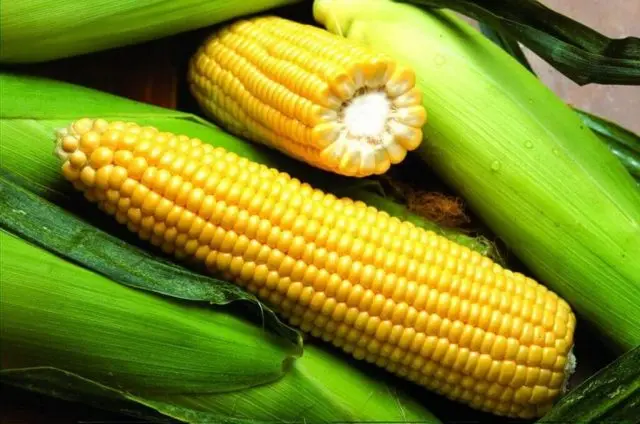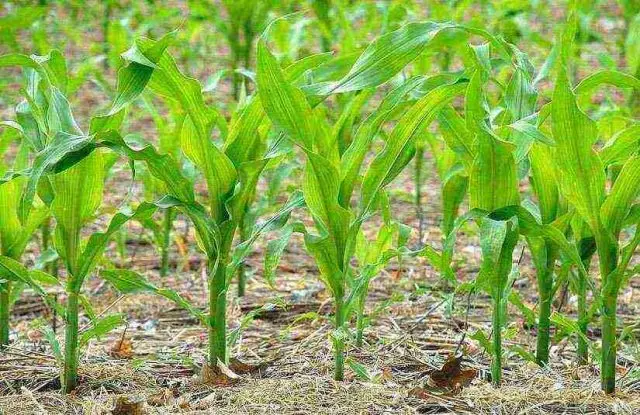Contents
Corn Lakomka 121 – refers to sugar early ripening varieties. This is a heat-loving plant, which, with proper care and timely hardening of sprouts, can be adapted to various climatic conditions.
Characterization
This corn variety was entered into the State Register in 2005. The selection of the Early Lakomka 121 variety was carried out by employees of the agricultural company Otbor.
The corn variety Lakomka gives a harvest in 2 months after emergence of shoots. Productivity from 1 ha – up to 4,8 tons of cobs. Conditioned ears make up more than 90% of the total crop.
Corn Lakomka is a bushy medium-sized plant. The height of the shoots reaches 1,5 m. Cobs with grains have a slightly conical shape. The length of the ears varies from 15 to 18 cm, the average weight is from 170 to 230 g.
Grains are large, tasty, sugary, quickly cooked. 10 minutes of boiling is enough for the grains to be used as food. The color of ripe grains is yellowish-orange, the peel is tender, thin. The speed of grain ripening and their excellent taste are the main advantages of Lakomka 121 corn variety. Grains of universal use, can be used fresh or boiled for food. Do not lose their taste when frozen. Used commercially for canning.

Growing rules
Before planting seeds, they must be prepared. Seeds are heated for 3–5 days at a temperature of +30 ° C, then soaked in warm water.
The beds, determined for Lakomka variety corn, are dug up and nitrogen fertilizers are applied. A plot of 10 m² will require 200 g of nutrient. Before planting seeds or seedlings, the earth is loosened to a depth of 10–12 cm.
To sow seeds in the ground, it is necessary to wait for the earth to warm up to +12 ° C. Approximate sowing time is the second decade of May. Planting dates depend on the region, for example, in the south, corn is sown at the end of April. Furrows are made in the garden, the distance between which should be at least 0,6 m. Seeds are laid out to a depth of 5–7 cm, 2 pieces each, maintaining a distance of 30–40 cm. The first shoots appear no earlier than after 10 days.
For regions with a possible frost threat in May, it is recommended to pre-plant seedlings. Seeds are planted in peat cups at the end of April. Seedlings are transferred to the ground in late May or early June. This allows you to protect the sprouts from nighttime lowering temperatures. Seedlings ready for planting in the ground should have 3 true leaves. The age of seedlings at this point reaches 30 days. Corn does not tolerate damage to the root system, so planting in peat cups is recommended. For planting corn, dig holes, the size of which is slightly larger than the container with seedlings. After planting, the plants are watered and the ground is mulched.
Soil requirements:
- light sandy, sandy loam and chernozems are the best option for growing corn;
- the earth must be air and water permeable;
- seeds germinate only in warm soil, so the soil temperature should be at least 10-12 ° C.
The optimal predecessors of corn on the site are tomatoes, melons and root crops. On a large scale, corn is sown after winter, leguminous and spring crops.
In order to harvest throughout the summer period, a conveyor planting method is used. To do this, corn is planted at intervals of two weeks.

Care
The corn variety Early Lakomka needs watering, loosening the soil, fertilizing and preventing diseases and pests.
Application of fertilizers
As fertilizers, it is recommended to use compost, humus, mullein or chicken manure. Top dressing is applied after six leaves have appeared on the seedling.
In the row-spacing, solutions of ammonium nitrate, superphosphate or potassium-containing fertilizers can be applied.
Weeding and loosening mode
Weeding and loosening is carried out at least three times per season. Loosening should be done carefully so as not to disturb the lateral roots.
Features of watering
The amount of watering is individual and depends on weather conditions. Strong waterlogging does not benefit the plant, but it should not be allowed to dry out the earthy coma. Mulching helps retain moisture after watering.
General recommendations
With the formation of side shoots-stepchildren, they should be removed. This will speed up the formation and ripening of the cobs.
Pest and disease control
Corn of different varieties, including Lakomka, can suffer from the following diseases:
- initial fusarium. The disease spreads in humid regions and leads to the defeat of ripe cobs by the fungus. The grains are covered with bloom, and the process of decay begins. Infected plants are removed from the site and burned;
- stem rot. You can detect the problem by the dark spots that appear on the bottom of the shoot. The disease leads to the defeat of the entire plant, so diseased specimens are removed and burned. The next year, before planting corn, the site is treated with fungicides or another place is chosen for the garden;
- corn rust characterized by the appearance of bright rusty spots on the underside of the leaf plate. This disease is caused by a fungus that forms spores on the foliage. As a preventive measure, it is recommended to treat seedlings with fungicides.
Of the insect pests that are dangerous for Lakomka corn, the following can be distinguished:
- click beetle larvae – wireworms. They damage the seeds and stems underground, resulting in the death of the plant. To combat them, pre-sowing spraying with insecticides or the introduction of granules into rows at the same time as planting seeds is used. You can use preparations Gaucho, Cosmos for dressing seeds;
- corn borer caterpillars penetrate the stems and damage the cobs. Lead to the spread of fusarium. Caterpillars are able to overwinter in corn shoots even at -25 °C. To combat them, insecticides are used, sprayed during the mass summer of butterflies;
- swedish fly lays eggs when two true leaves appear on corn seedlings. The larvae damage the shoots, inhibiting their growth and leading to the death of the plant. To combat them, insecticides or seed dressing are used.
Reviews
Conclusion
Lakomka corn is a high-yielding sugar variety suitable for growing in small plots and on an industrial scale. Compliance with the requirements of agricultural technology allows to achieve high yields.









